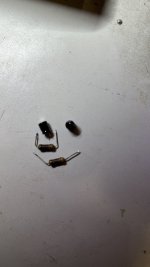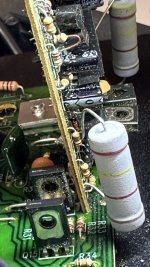Capacitor Sizes: Within a given series, both the diameter and length will typically increase. The very best volumetric efficiency caps for bulk storage are solid Tantalum. For MIL-SPEC devices check M39003. They cost a premium, typically 10x the cost of commercial. For commercial or industrial temperature grades, look up KEMET 35 Vdc 220uF capacitor. It should come up in the first two or three hits. You want a leaded type; e.g. Radial or Axial, not SMT. Kemet has been making caps since I started in RADAR about 45 years ago- good stuff. Digi-Key and Mouser are good sources.
For C8, I substituted a 35 Vdc 470uF Axial lead component. It is physically larger but fit with a vertical orientation. I probably should have gone the Kemet- Tantalum route for higher reliability and better performance. Amazon had the electrolytics in stock with one-day shipping. Cost an exorbitant $4.00 for two good quality Nichon caps.
For C8, I substituted a 35 Vdc 470uF Axial lead component. It is physically larger but fit with a vertical orientation. I probably should have gone the Kemet- Tantalum route for higher reliability and better performance. Amazon had the electrolytics in stock with one-day shipping. Cost an exorbitant $4.00 for two good quality Nichon caps.
Mouser, Digi-Key and other parts sites may have tables for the size.
Compare those with what you have, a 1 mm resolution is enough, so a scale or tape measure is enough, no need for calipers.
And see how much room is available if the new one is slightly fatter.
It is in an enclosed space, so I fear you may have more failures in the future.
See if you can replace all the capacitors, and move it to a place with better ventilation, if not already so.
Compare those with what you have, a 1 mm resolution is enough, so a scale or tape measure is enough, no need for calipers.
And see how much room is available if the new one is slightly fatter.
It is in an enclosed space, so I fear you may have more failures in the future.
See if you can replace all the capacitors, and move it to a place with better ventilation, if not already so.
I ordered 2 of each though radial. Each is Kemet though not tantalum.Capacitor Sizes: Within a given series, both the diameter and length will typically increase. The very best volumetric efficiency caps for bulk storage are solid Tantalum. For MIL-SPEC devices check M39003. They cost a premium, typically 10x the cost of commercial. For commercial or industrial temperature grades, look up KEMET 35 Vdc 220uF capacitor. It should come up in the first two or three hits. You want a leaded type; e.g. Radial or Axial, not SMT. Kemet has been making caps since I started in RADAR about 45 years ago- good stuff. Digi-Key and Mouser are good sources.
For C8, I substituted a 35 Vdc 470uF Axial lead component. It is physically larger but fit with a vertical orientation. I probably should have gone the Kemet- Tantalum route for higher reliability and better performance. Amazon had the electrolytics in stock with one-day shipping. Cost an exorbitant $4.00 for two good quality Nichon caps.
I have an SA240 - low output, crackle and loud pops, and the resistors were getting hot and cooked. I replaced C10 and C11 with higher voltage caps - no change in output. I also changed the cooked resistors to 5w and they haven’t gotten hot yet. I haven’t used the amp long enough to see if the crackles or pops happen still, but if they return I will clean out the switch.
Attachments
Hi,
I have the SPA250 version, and I am experiencing a very high pitched sound (coming from inside) every time the plate amp is turned on.
The unit is relatively new, and is functioning properly, except for that annoying high pitched sound.
I of course already complained this to PE, but unfortunately cannot be returned already (different country).
What do you guys think is the probable cause? Maybe a vibrating component? Anyone experienced this issue?
I have the SPA250 version, and I am experiencing a very high pitched sound (coming from inside) every time the plate amp is turned on.
The unit is relatively new, and is functioning properly, except for that annoying high pitched sound.
I of course already complained this to PE, but unfortunately cannot be returned already (different country).
What do you guys think is the probable cause? Maybe a vibrating component? Anyone experienced this issue?
What I noticed from pictures of the burned soft clip PCB: The burn and heat marks show the amp has been operated face down for a long time. Heat goes up, not sideways.
This doesn't matter from a customers standpoint, as the Zener/ resistor regulation is simply a construction fault, made by someone who wanted to save on the proper parts, an extra transistor and capacitor. They knew how critical it was, as they put the resistor on long legs to give better cooling. The usual 7818 and 7918 regulators are not suited for the high rail voltage. Anyway, if the plate amp is operated in the "normal" orientation, they might last longer, until another "no quality" part blows. Like the other capacitor problems, a few centimeter away: An average 105°C 25Volt cap should stand 18V forever, so these must be the worst China had to offer.
For the burning resistors, simply replacing them with more Watt versions may be the wrong way, as the next part to fail is the Zener which is working on it's limit too. Double of the resistance ( 2.4k stock) reduces the dissipated heat and may still serve the opamp. I would try 3.7k Ohm.
How to do such a voltage reduction correctly is shown in the amps PS: A Zener, transistor, resitor and capacitor only burn the current needed. These 35 Cent in parts are too much for a poor company like PE. They seem to earn more money by replacing any 3rd amp they selll with a new one from time to time...
This doesn't matter from a customers standpoint, as the Zener/ resistor regulation is simply a construction fault, made by someone who wanted to save on the proper parts, an extra transistor and capacitor. They knew how critical it was, as they put the resistor on long legs to give better cooling. The usual 7818 and 7918 regulators are not suited for the high rail voltage. Anyway, if the plate amp is operated in the "normal" orientation, they might last longer, until another "no quality" part blows. Like the other capacitor problems, a few centimeter away: An average 105°C 25Volt cap should stand 18V forever, so these must be the worst China had to offer.
For the burning resistors, simply replacing them with more Watt versions may be the wrong way, as the next part to fail is the Zener which is working on it's limit too. Double of the resistance ( 2.4k stock) reduces the dissipated heat and may still serve the opamp. I would try 3.7k Ohm.
How to do such a voltage reduction correctly is shown in the amps PS: A Zener, transistor, resitor and capacitor only burn the current needed. These 35 Cent in parts are too much for a poor company like PE. They seem to earn more money by replacing any 3rd amp they selll with a new one from time to time...
Heat marks were on my amp’s PCB since shortly after I bought it and the crackle started. It has always been operated in the proper position. Of course it gets hot and stays hot here in Arizona, USA.
I noticed before (and will try again next time I get to it) that a hotter source helps out the amp’s output. Last time I was using it, I fed the low level RCA inputs with a signal from a stereo tpa3118 chipamp.
I wonder if there is something I could modify so the preamp gives the power amp more juice?
I noticed before (and will try again next time I get to it) that a hotter source helps out the amp’s output. Last time I was using it, I fed the low level RCA inputs with a signal from a stereo tpa3118 chipamp.
I wonder if there is something I could modify so the preamp gives the power amp more juice?
Member 1152: RE SA240
I have never seen this amp, but it is supposedly similar to the SPA250. Known problems include the resistors for the Zener diodes and the bleeder resistors for the main filter caps. (New Values are 3k0 @ 2W). The caps are notoriously cheap and unreliable. Use a magnifier to carefully check for bulging endcaps. I had a bad one at C8. Good luck and please let us know what you find. Cheers- EVMan
I have never seen this amp, but it is supposedly similar to the SPA250. Known problems include the resistors for the Zener diodes and the bleeder resistors for the main filter caps. (New Values are 3k0 @ 2W). The caps are notoriously cheap and unreliable. Use a magnifier to carefully check for bulging endcaps. I had a bad one at C8. Good luck and please let us know what you find. Cheers- EVMan
Member RXV: RE SPA250
Como esta? That is an interesting problem. The amplifier is hard band limited at 180 Hz. It uses a linear power supply versus switcher, There should be no high frequency content at all. Even if the amp malfunctioned and passed high frequencies, the sub should driver should not reproduce them. Not loudly anyway. Others will likely lend a hand here. My only guess would be an air leak- the pistonic movement of the driver acting as a compressor to excite a resonant leak. Almost like a whistling sound. . . Please keep us posted- this is an interesting one.
Como esta? That is an interesting problem. The amplifier is hard band limited at 180 Hz. It uses a linear power supply versus switcher, There should be no high frequency content at all. Even if the amp malfunctioned and passed high frequencies, the sub should driver should not reproduce them. Not loudly anyway. Others will likely lend a hand here. My only guess would be an air leak- the pistonic movement of the driver acting as a compressor to excite a resonant leak. Almost like a whistling sound. . . Please keep us posted- this is an interesting one.
Member 1152: RE Hotter source
You said, "I noticed before (and will try again next time I get to it) that a hotter source helps out the amp’s output. Last time I was using it, I fed the low level RCA inputs with a signal from a stereo tpa3118 chipamp." Isn't the TPA3118 a power amp? Low level inputs are lower, line levels. These typically are generated by a pre-amp somewhere upstream. A power amp driven into the SPA250 line level inputs is asking for trouble. . .
You said, "I noticed before (and will try again next time I get to it) that a hotter source helps out the amp’s output. Last time I was using it, I fed the low level RCA inputs with a signal from a stereo tpa3118 chipamp." Isn't the TPA3118 a power amp? Low level inputs are lower, line levels. These typically are generated by a pre-amp somewhere upstream. A power amp driven into the SPA250 line level inputs is asking for trouble. . .
The high pitched sound is heard as long as the amp is turned on. My guess is around the 15,000-20,000hz range (yes, very faint, but audible)Does the sound stay or go away after a moment? Why not open it and find the source for the sound or does it come from the speaker?
This probably would not be heard if you are maybe 5 meters away, but if you're near the plate amp, yes it is very annoying.
I didn't want to open the insides of the amp, as it is relatively brand new. Maybe I'll do it in the worst case scenario that I don't get any answers
Member RXV: RE SPA250
Como esta? That is an interesting problem. The amplifier is hard band limited at 180 Hz. It uses a linear power supply versus switcher, There should be no high frequency content at all. Even if the amp malfunctioned and passed high frequencies, the sub should driver should not reproduce them. Not loudly anyway. Others will likely lend a hand here. My only guess would be an air leak- the pistonic movement of the driver acting as a compressor to excite a resonant leak. Almost like a whistling sound. . . Please keep us posted- this is an interesting one.
Apologies, I think you misunderstood the issue.
There is no high frequency passing through the drivers (the internal filters are working properly).
The plate amp itself is making the high pitched noise. My guess is around the 15,000-20,000hz range (yes, very faint, but audible)
And no, there is no air leak, since the plate amp is not even mounted into a subwoofer box (yet).
Here is what Parts Express helpdesk had to say (they are very responsive and helpful by the way):
"Unfortunately, it appears there is a hardware component that is becoming excited within the unit that is causing the high-pitched frequency output from the chassis/ internal componentry of the amplifier. My only presumption would be a coil whine that can occur if an inductor winding is vibrating where it should remain stationary. The best course of action would be to proceed with a warranty return for exchange."
The apologies are mine to make. I totally misunderstood the problem. The amplifier is not installed in the enclosure. The Line Voltage switch is set correctly. The unit emits a high pitch whine when power is applied without any audio. Yikes.
If the SPA250 is emitting a high-pitched whine, something is resonating, mechanically or electrically. If you can return the unit, you should probably do so. If the warranty is invalid, there is little choice but to open the amplifier up and take a look around. Ensure the power is removed before disassembly. A good visual inspection might reveal an obvious problem, e. g. buckled cap, burned resistor, etc. You can also check the mechanical connections and look/feel for vibration points. An orange stick and a stethoscope are unconventional, but effective when checking for vibrations and air leaks.
The only inductive components in the circuit are the power relay’s coil and the power transformer. Power transformers usually hum at the AC Line frequency or a harmonic- all low frequency stuff. Although, at least one power transformer has been reported as being bad. The relay’s coil is a stretch, but surrounding circuitry could change values to form a resonant tank circuit. This is not a straight forward problem. Please keep us posted and good luck. EVMan
If the SPA250 is emitting a high-pitched whine, something is resonating, mechanically or electrically. If you can return the unit, you should probably do so. If the warranty is invalid, there is little choice but to open the amplifier up and take a look around. Ensure the power is removed before disassembly. A good visual inspection might reveal an obvious problem, e. g. buckled cap, burned resistor, etc. You can also check the mechanical connections and look/feel for vibration points. An orange stick and a stethoscope are unconventional, but effective when checking for vibrations and air leaks.
The only inductive components in the circuit are the power relay’s coil and the power transformer. Power transformers usually hum at the AC Line frequency or a harmonic- all low frequency stuff. Although, at least one power transformer has been reported as being bad. The relay’s coil is a stretch, but surrounding circuitry could change values to form a resonant tank circuit. This is not a straight forward problem. Please keep us posted and good luck. EVMan
Thank you for your reply EVMan, much appreciate it.
Yes it is possible that a component inside is resonating mechanically.
I probably have no choice but to take a peek inside (if my courage allows me to do so )
)
NOTE: I have another unit (the same model) which is probably already 5 years old, without any issues whatsoever.
So this new unit might be a new batch (with some possible different used parts inside).
Yes it is possible that a component inside is resonating mechanically.
I probably have no choice but to take a peek inside (if my courage allows me to do so
NOTE: I have another unit (the same model) which is probably already 5 years old, without any issues whatsoever.
So this new unit might be a new batch (with some possible different used parts inside).
“NOTE: I have another unit (the same model) which is probably already 5 years old, without any issues whatsoever. So, this new unit might be a new batch (with some possible different used parts inside).” RXV
The SPA250 has indeed gone through multiple revisions. I have had three SPA250 units go bad (Zener Resistors, DOA, C8). The first thing to check is mechanical vibration. Can you feel any vibration at all? If you can probe with an orange stick, the whine’s pitch might change when you get close. Hopefully, a visual inspection will reveal the culprit. Good luck. EVMan
The SPA250 has indeed gone through multiple revisions. I have had three SPA250 units go bad (Zener Resistors, DOA, C8). The first thing to check is mechanical vibration. Can you feel any vibration at all? If you can probe with an orange stick, the whine’s pitch might change when you get close. Hopefully, a visual inspection will reveal the culprit. Good luck. EVMan
Yes, but I had to feed a hotter signal (not at full volume, of course) for any decent output from the SA240 to match my full range speakers. Hence my wondering if there was something to modify/repair in the preamp section. The amp worked fine for a while after I received it as a replacement to the bass-boosted model that was unusable. Well, up until the crackling and the gunshot sounds at 4am from 2 12” subs while on standyby.Member 1152: RE Hotter source
You said, "I noticed before (and will try again next time I get to it) that a hotter source helps out the amp’s output. Last time I was using it, I fed the low level RCA inputs with a signal from a stereo tpa3118 chipamp." Isn't the TPA3118 a power amp? Low level inputs are lower, line levels. These typically are generated by a pre-amp somewhere upstream. A power amp driven into the SPA250 line level inputs is asking for trouble. . .
Your problem description a bit confused, plus I have never seen a SA240 plate amp. If you require a large signal for audio, it sounds like the preamp front end and/or following gain stages. Most preamps have a voltage gain of 26 dB and are capable of driving two volts into a 10K Ohm load. Crackling and popping sounds indicate something(s) went bad. The SPA250 has a summing Op-amp circuit that combines left and right channels. Simply using a ‘Y’ Adapter and driving both inputs will double the output for a give gain setting. Any chance that you can find a schematic online? Good luck. EVMan
EVMan: Haven’t been able to find a schematic. Here are recent pics of the guts:
Attachments
-
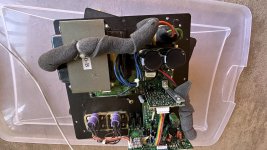 807BBD36-57A9-4191-B238-EA4222E01A2D.jpeg408.1 KB · Views: 72
807BBD36-57A9-4191-B238-EA4222E01A2D.jpeg408.1 KB · Views: 72 -
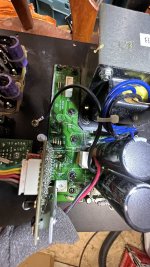 D0B2AB54-1DEB-4821-8D98-2A7894355E03.jpeg392.8 KB · Views: 71
D0B2AB54-1DEB-4821-8D98-2A7894355E03.jpeg392.8 KB · Views: 71 -
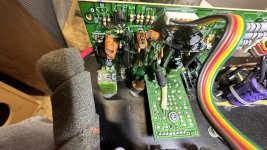 6C6CB2C3-7073-46B4-A194-FCCA4FC00A85.jpeg445.4 KB · Views: 75
6C6CB2C3-7073-46B4-A194-FCCA4FC00A85.jpeg445.4 KB · Views: 75 -
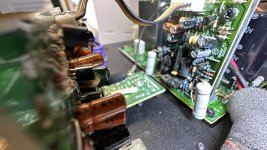 DD810440-59D0-450D-83A9-F02CB995AECB.jpeg334.6 KB · Views: 69
DD810440-59D0-450D-83A9-F02CB995AECB.jpeg334.6 KB · Views: 69 -
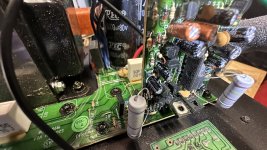 E79E5EA5-8CB4-490D-9F69-301C4B58B8B6.jpeg421.5 KB · Views: 74
E79E5EA5-8CB4-490D-9F69-301C4B58B8B6.jpeg421.5 KB · Views: 74
- Home
- Loudspeakers
- Subwoofers
- Dayton SPA250 Plate Amplifier repair help
